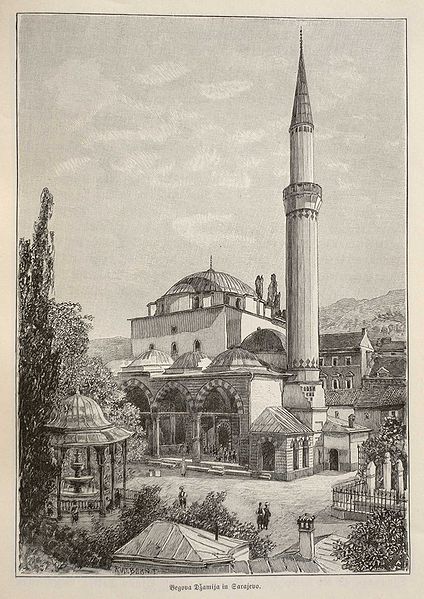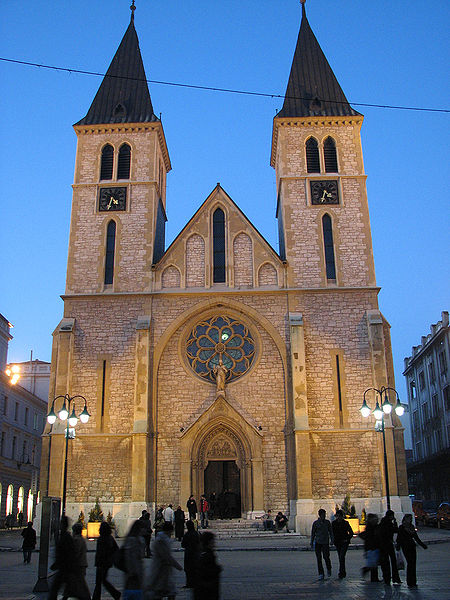Stari Grad (meaning "old city") is a municipality in
Bosnia and Herzegovina. It is the oldest and most historically
significant part of Sarajevo. At its heart is the
Bašcaršija, the old town market sector where the city
was founded by the Ottomans in the 15th century.
The municipality of Stari Grad is characterized by its
many religious structures, and examples of unique Bosnian
architecture. The eastern half of Stari Grad consists of the
Ottoman influenced sectors of the city, while the western half
showcases an architecture and culture that arrived with
Austria-Hungary, symbolically representing the city as a meeting
place between East and West.
Stari Grad contains numerous hotels and tourist
attractions including the Gazi Husrev-beg's Mosque, Tzar's Mosque,
and the Sarajevo Cathedral.
To get the cache, you'll have to pass in some points of
this beautiful city and answer some questions.
Stage 1: N43 51.553 E18 25.862

Bašcaršija is considered to be the main
street of Sarajevo and one of its most important landmarks. It is
located in the old town part of Sarajevo, designed in the
Ottoman-Turkish style and loaded with souvenir shops and public
fountains. It contains a bazaar that sells all kinds of metalwork,
jewellery and pottery. Each street is dedicated to a different
craft. It is built in the 16th century.
The word Bašcaršija derives from Turkish
language. The word "baš" which is "bas" in Turkish literally
means "head", in some contexts however also "primary", "main",
"capital" and "caršija" which is "çarsi" in Turkish
means "bazaar" or "market". hence - main market.
Here you'll have to check the number on the
green plate on the mosque outside wall. This number is A.
Stage 2: N43 51.561 E18 25.721

The Gazi Husrev-Beg Mosque (Bosnian: Gazi Husrev-begova
Džamija, Turkish: Gazi Hüsrev Bey Camii), often referred
to as the Beg's Mosque, is a mosque in the city of Sarajevo, Bosnia
and Herzegovina. It is considered the most important Islamic
structures in the country and one of the world's finest examples of
Ottoman Architecture. It is located in the Bašcaršija
neighborhood in the Stari Grad municipality, and remains one of the
most popular centers of worship in the city.
The mosque was financed in 1531 by Gazi Husrev-beg, the
provincial governor of Bosnia. Husrev-beg is widely considered
Sarajevo's greatest patron, as he financed much of Sarajevo's old
city at this time.
The Gazi Husrev-Beg Mosque was built by the famous Ottoman
architect Mimar Sinan, who would later go on to build the Selimiye
Mosque in Edirne for the Sultan Selim I. Gazi Husrev-beg also built
the same mosque called Hüsreviye Mosque in Aleppo, Syria,
between 1531 and 1534.
During the Siege of Sarajevo, Serbian forces purposely
targeted many centers of the city's culture and fired from them at
large, such as museums, libraries, and mosques. As the largest and
most well known, the Beg's mosque was an obvious target. Heavily
damaged in the war, it was renovated in 1996 with foreign help.
Prior to reconstruction, the interior was far more intricate, but
today the walls are simply white, much of the detail, artistry, and
color taken out. Complete restoration and re-painting of mosque
began in 2000. It has been done mainly by Hazim Numanagic, a
Bosnian calligrapher.
Here you'll have to check the year on the right
bottom of the left panel found on the wall of the main mosque near
the fountain. This number is B.
Stage 3: N43 51.558 E18 25.531

The Cathedral of Jesus'
Heart in Sarajevo, commonly referred as the Sarajevo Cathedral is
the largest cathedral in Bosnia and Herzegovina. It is the seat of
the Vrhbosanski Archbishop, and center of Catholic worship in the
city. The Cathedral is located in the city's Old Town district. The
Cathedral of Jesus Heart was built in honor of "Jesus Sacred
Heart", an important Catholic concept. Architect Josip
Vancaš modeled it after the Notre-Dame de Paris using the
neo-Gothic style and elements of Romanesque architecture. Work
began on August 25, 1884, and was completed in the same month in
1889.
The building was
damaged during the Siege of Sarajevo, but was not completely
destroyed, and the damage has since been repaired. The building is
often used as a symbol of the city: The design above the door to
the Cathedral is part of the flag and seal of Sarajevo Canton and
the Romanesque towers are featured on the flag and coat of arms of
Sarajevo.
Here
you'll have to check how many bells are housed in the two towers.
You can check for the answer in the informative plate in front of
the cathedral. This number is C.
As a
checksum: A + B + C = 2041.
Now
use those numbers and calculate the coordinates of the cache: N43
51.((B/2) - 500) E18 25.((A*C*2)+20)